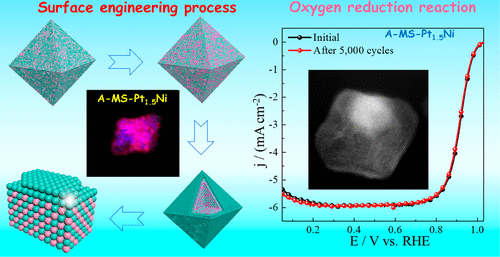当前位置:
X-MOL 学术
›
ACS Catal.
›
论文详情
Our official English website, www.x-mol.net, welcomes your
feedback! (Note: you will need to create a separate account there.)
Active and Stable Pt–Ni Alloy Octahedra Catalyst for Oxygen Reduction via Near-Surface Atomical Engineering
ACS Catalysis ( IF 11.3 ) Pub Date : 2020-03-19 , DOI: 10.1021/acscatal.9b05133 Fanpeng Kong 1, 2 , Zhouhong Ren 3 , Mohammad Norouzi Banis 2 , Lei Du 1 , Xin Zhou 1 , Guangyu Chen 1 , Lei Zhang 2 , Junjie Li 2 , Sizhe Wang 2 , Minsi Li 2 , Kieran Doyle-Davis 2 , Yulin Ma 1 , Ruying Li 2 , Alan Young 4 , Lijun Yang 4 , Matthew Markiewicz 4 , Yujin Tong 5 , Geping Yin 1 , Chunyu Du 1 , Jun Luo 3 , Xueliang Sun 2
ACS Catalysis ( IF 11.3 ) Pub Date : 2020-03-19 , DOI: 10.1021/acscatal.9b05133 Fanpeng Kong 1, 2 , Zhouhong Ren 3 , Mohammad Norouzi Banis 2 , Lei Du 1 , Xin Zhou 1 , Guangyu Chen 1 , Lei Zhang 2 , Junjie Li 2 , Sizhe Wang 2 , Minsi Li 2 , Kieran Doyle-Davis 2 , Yulin Ma 1 , Ruying Li 2 , Alan Young 4 , Lijun Yang 4 , Matthew Markiewicz 4 , Yujin Tong 5 , Geping Yin 1 , Chunyu Du 1 , Jun Luo 3 , Xueliang Sun 2
Affiliation

|
Shape-controlled Pt-based bimetallic nanocrystals with ultrathin Pt-rich surfaces are appealing electrocatalysts for some key electrochemical reactions such as the oxygen reduction reaction (ORR) because of the synergistic tuning of topological atom configuration and strengthened electronic effects. However, it is rather challenging to fabricate such particular structures that can remain intact in harsh electrochemical environments, as such Pt-based nanocatalysts are unable to simultaneously achieve both unparalleled activity and robust stability. Here, a facile surface engineering strategy is proposed and employed to atomically tailor the near-surface structure of the Pt1.5Ni octahedra. The engineered Pt–Ni octahedra consist of an ultrathin Pt-rich shell (∼two atomic layers) and Pt-rich bulk composition. The optimized octahedral catalyst exhibits superior specific and mass activity (7.7 mA/cm2Pt and 1.9 A/mg Pt at 0.9 V) for ORR, ∼20 and ∼10 times higher than commercial Pt/C, respectively. The ligand and strain effects arising from the near-surface engineering are unraveled to be responsible for the remarkable ORR activity. Moreover, it shows robust stability with just 9.2% decay in mass activity after accelerated degradation tests (ADTs), as its compositional nature prevents surface Pt atoms and interior Ni atoms from diffusion and dissolution, compared with a decrease of 33% for commercial Pt/C. Our atomical engineered surface strategy illustrates a facile and effective design for a class of Pt-based nanocatalysts with excellent activity and stability.
中文翻译:

活性和稳定的Pt-Ni合金八面体催化剂,用于通过近表面原子工程还原氧气
具有超薄富Pt表面的形状可控的基于Pt的双金属纳米晶体吸引了一些关键的电化学反应(如氧还原反应(ORR))的电催化剂,这是由于拓扑原子构型的协同调节和增强的电子效应所致。然而,制造在恶劣的电化学环境中保持完整的特定结构是相当具有挑战性的,因为这种基于Pt的纳米催化剂无法同时实现无与伦比的活性和坚固的稳定性。在此,提出了一种简便的表面工程策略,并采用该方法原子地裁剪了Pt 1.5的近表面结构。镍八面体。工程化的Pt-Ni八面体由超薄的富含Pt的壳(约2个原子层)和富含Pt的本体组成。优化的八面体催化剂表现出优异的比活性和质量活性(7.7 mA / cm 2 Pt和1.9 A / mg Pt对于ORR,在0.9 V时)分别比商用Pt / C高20倍和10倍。揭示了由近表面工程引起的配体和应变效应是造成显着ORR活性的原因。此外,由于其成分性质阻止表面Pt原子和内部Ni原子扩散和溶解,而商用Pt /降低了33%,因此它在加速降解试验(ADT)后显示出强大的稳定性,质量活性仅下降9.2%。 C。我们的原子工程表面策略说明了一种具有出色活性和稳定性的,基于Pt的纳米催化剂的简便有效的设计。
更新日期:2020-03-20
中文翻译:

活性和稳定的Pt-Ni合金八面体催化剂,用于通过近表面原子工程还原氧气
具有超薄富Pt表面的形状可控的基于Pt的双金属纳米晶体吸引了一些关键的电化学反应(如氧还原反应(ORR))的电催化剂,这是由于拓扑原子构型的协同调节和增强的电子效应所致。然而,制造在恶劣的电化学环境中保持完整的特定结构是相当具有挑战性的,因为这种基于Pt的纳米催化剂无法同时实现无与伦比的活性和坚固的稳定性。在此,提出了一种简便的表面工程策略,并采用该方法原子地裁剪了Pt 1.5的近表面结构。镍八面体。工程化的Pt-Ni八面体由超薄的富含Pt的壳(约2个原子层)和富含Pt的本体组成。优化的八面体催化剂表现出优异的比活性和质量活性(7.7 mA / cm 2 Pt和1.9 A / mg Pt对于ORR,在0.9 V时)分别比商用Pt / C高20倍和10倍。揭示了由近表面工程引起的配体和应变效应是造成显着ORR活性的原因。此外,由于其成分性质阻止表面Pt原子和内部Ni原子扩散和溶解,而商用Pt /降低了33%,因此它在加速降解试验(ADT)后显示出强大的稳定性,质量活性仅下降9.2%。 C。我们的原子工程表面策略说明了一种具有出色活性和稳定性的,基于Pt的纳米催化剂的简便有效的设计。











































 京公网安备 11010802027423号
京公网安备 11010802027423号